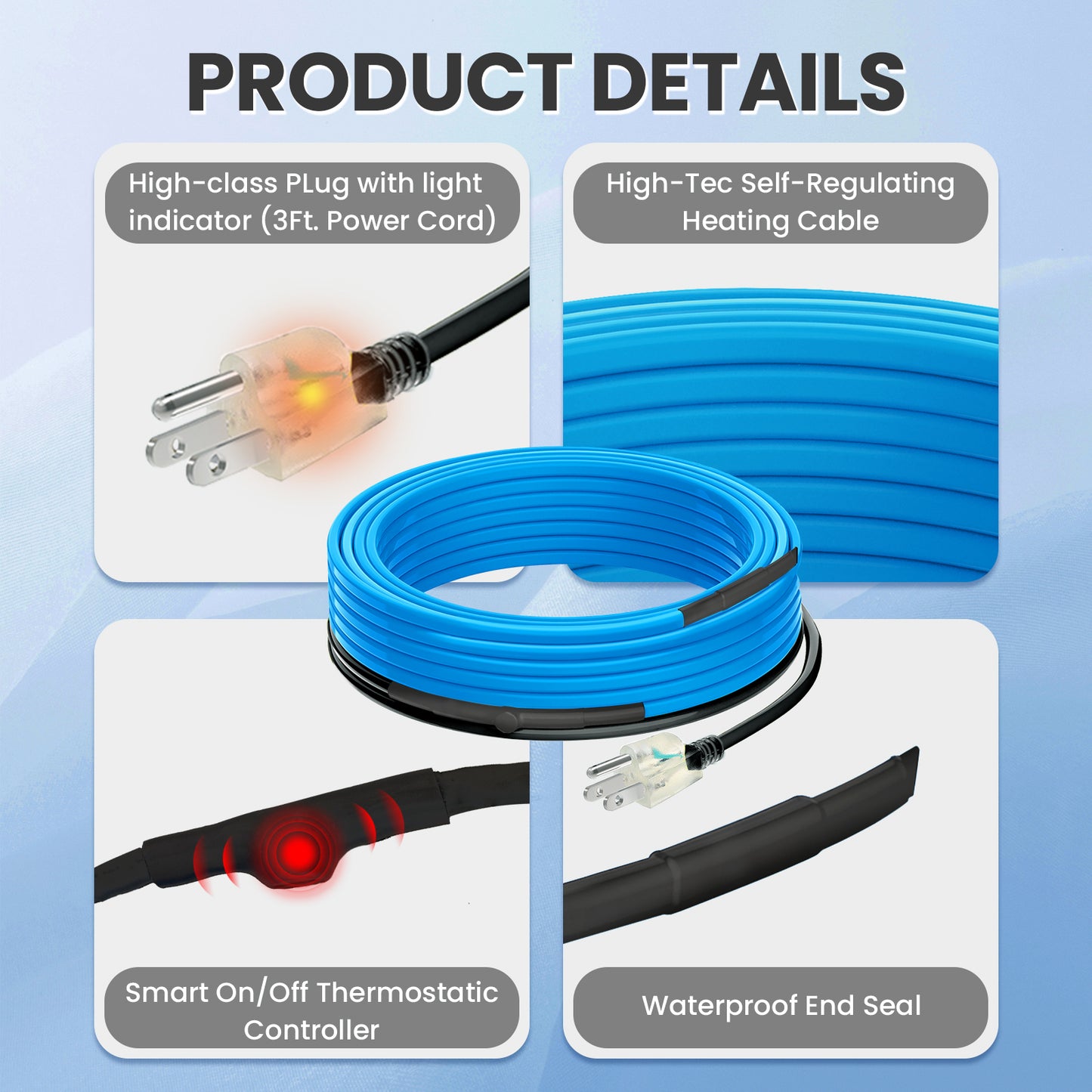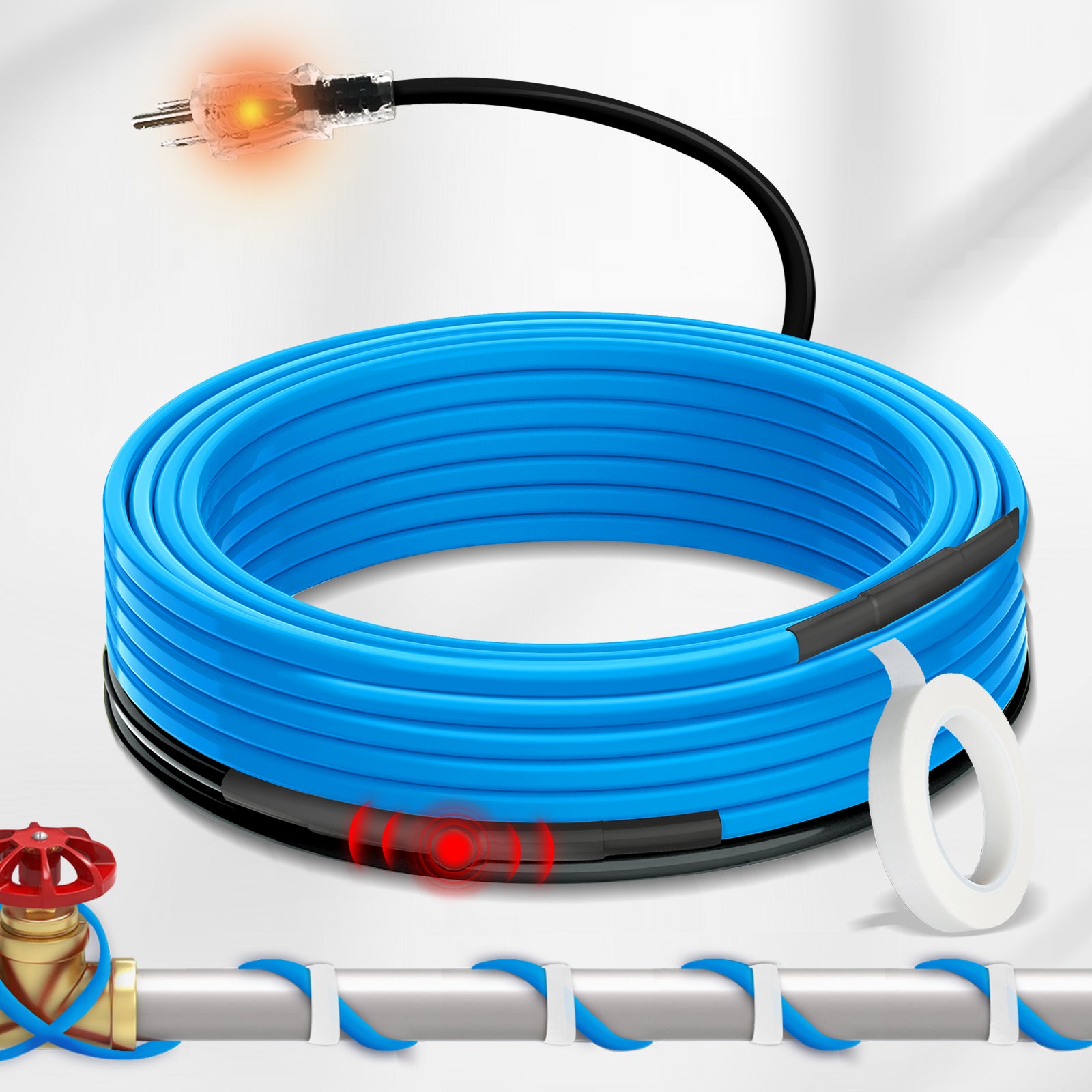











Frequently Asked Questions (FAQs)
Questions & Answers
Have a Question?
-
What is the diameter of this product
Thanks for your question!
The diameter is 0.3 x 0.2 inches.
If you have other questions ,please email us ( maxkosko@maxkosko.com)
-
DIFFERNCE BETWEEN THE BLUE AND GREEN SELF REGUALTING TAPE
Thank you for your question!
You can find the detailed information through this link.
https://maxkosko.com/collections/pipe-freeze-protection
The blue self-regulating heating cable comes with a thermostat that automatically turns on at 37°F and off at 50°F, providing energy savings by only operating when necessary.
The green self-regulating heating cable does not have a thermostat, but it still adjusts its output power based on the temperature. It starts working once plugged in and stops when power is turned off. This version is ideal for situations where part of the pipe is indoors and part is outdoors, or in environments with significant temperature differences.
Let us know if you need further assistance!
Best regards,
-
how hot does the tape get?
The maximum temperature the cable can reach is 140°F (60°C).
-
How long is unheated black extension part of the cord?
The black power cord is 3ft. So, if you choose a 6ft heat cable, the total length you’ll receive will be 9ft.
-
Can the cables be plugged into each other?
No, can't be plugged into each other.
-
Can this blue heat tape be used on RV sewer pipe? Also, for any pipes does it HAVE TO be covered with insulation? Also, the thermostat is not able to touch the pipe and then reach the outlet but is sitting in foam pipe insulation. is that okay? thanks.
We've seen other users use the blue heat tape for RV sewer pipes. However, it's not strictly necessary to cover it with insulation, but doing so can reduce heat loss, especially in low-temperature conditions.
Regarding the thermostat, it must be in direct contact with the pipe or hose to accurately sense the temperature and trigger the heating cable to work. If the thermostat is placed on insulation, it will sense the insulation's temperature rather than that of the pipe. -
Hello, I recently bought the Maxkosko blue pipe heating cable with self regulating technology. The package says it can be installed on commercial and residential plastic or metal pipes. Can you tell me how hot this cable will get? Thanks!
It can reach up to 130°F under normal operating conditions
-
I need to keep a water line from a pond to a pump from freezing to get water to horses. Can the heat line be used under ice and water into the pond?
It's not recommended.
If the heating cable needs to be submerged in water for an extended period, you may consider using our in-line heating cable. For more information, please check out our in-line heating cable product here [MAXKOSKO In Pipe Heating Cable].
-
When I plug it into the outlet, should the cable light light up right away or only one falls below 38°
When plugged into the outlet, the cable light lights up right away. But please note the lighted plug just tells the cable is on power.
It doesn't mean the cable is heating because there is a thermostat, which will only turn on the heating cable at below 38℉. -
Hello. Can I use the cable on an RV water supply hose? Essentially a drinking water quality grade garden hose . The hose won't be buried. It's about 10' running along the ground coming from a heated room in the house directly into to the (heated) RV parked 10' away. Temps here generally not below-15c, but can get short cold snaps to -25 . Thank you!
Yes, you can use the pipe heating cable for your RV water supply hose. For optimal results, we recommend insulating the hose after installation.
Please check the link below: https://outdoormiles.com/diy-heated-rv-water-hose/ -
I bought your 160 foot pipe cable and I need another 40 foot to keep the whole pipe protected. Is there an extension kit, or a 200 foot kit that you can sell me?
There isn’t a 200ft cable available due to the Amps limit of this self-regulating heating cable.
This is a pre-assembled heating cable and can’t be cut or extended by end users.
Yes, you can add another 40ft of cable, and plug it in another outlet.
-
Can you send me instructions for install on direct burial pet well line.
Thank you for your question.
This product is not designed to be buried underground, but some customers use it that way. Please be sure to pay attention to potential hazards during use, such as reduced service life of heating cables, moisture-caused faults, uneven heating, ground shifts, maintenance complexity, utility interference, insulation issues, environmental impact, and non-compliance with regulations.
If you decided to install, here are some simple installation steps for your reference:
1. Choose a route: Plan the path from the well to the desired location, avoiding obstacles.
2. Dig the trench: Dig a trench below the frost line, ensuring proper depth and width.
3. Install cables onto the pipeline for effective and organized wiring.
4. Insulate and protect: Wrap the line with insulation and protective tape to prevent damage.
5. Lay the line: Place the pet water line in the trench, using flexible tubing suitable for burial.
6. Bury carefully: Backfill the trench, tamping down the soil as you go.
7. Test the line: Check for leaks and proper water flow.
8. Mark the line: Use markers to indicate the line's location for future reference.
Remember to adhere to local codes and guidelines for safe installation. -
How does a heat tape for pipes work?
Attaching a heating cable to a pipe transfers heat to prevent freezing. Pairing it with pipe insulation ensures even heat distribution and slows down heat dissipation.
-
What is heat trace?
Electric heating cables, such as heat trace, heat tape, or heating cable, can be attached to pipes, preventing freezing and enabling water flow in non-flowing pipes within poorly insulated perimeter walls, even in harsh winter conditions.
-
Will heat tape really keep my pipes from freezing?
Yes, the appropriate type of heat tape can effectively prevent pipes from freezing. It applies gentle heat to prevent water in the pipes from freezing and blocking water flow. When used in conjunction with proper insulation, heat tape helps regulate the temperature of water pipes.

























